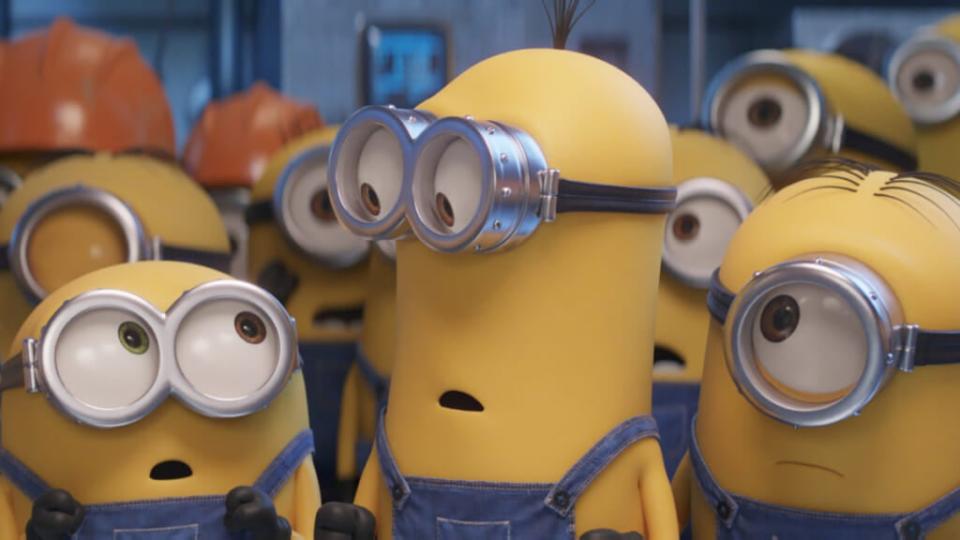‘Minions: The Rise of Gru’ Film Review: Yellow Subservients Return, More Irritating Than Ever

Jaundiced critters wired for subservience, the Minions have become an inescapable nuisance across all entertainment media and even theme parks. Their overly simplistic design and mostly unintelligible dialect has turned them into an easily marketable brand that amuses young audiences with their frantic, infantile and irritating personalities.
Unnecessarily, their insufferable dominance expands further with a new movie, “Minions: The Rise of Gru,” from director Kyle Balda, a creator involved in this hollow animated emporium since the original “Despicable Me” film now over a decade ago.
No longer searching for a master to serve after meeting Gru (voiced by Steve Carell) at the end of 2015’s “Minions,” the first prequel in this universe, the roundish sidekicks have settled into the young villain’s home. But their ideal living situation is disturbed when their 12-year-old boss (the film is set in the 1970s) wants to join the Vicious 6, a criminal organization comprised of the most dangerous antagonists. That one of them is an evil nun is the film’s funniest gag.
Also Read:
‘Minions: The Rise of Gru’ Trailer Shows Origin Story of Steve Carell’s Supervillain (Video)
During the opening sequence, the Vicious 6 travel to a remote location to retrieve “the zodiac stone,” their version of the type of clichéd powerful and mystical relic villains are often after, and they betray their leader Wild Knuckles (Alan Arkin) — Gru’s hero — to obtain it. Soon after, Gru interviews to fill in the vacant position, but when rejected given his tender age, he steals the precious gem from them, and thus begins a cross-country chase.
Those invested in the lore of these movies will find references to characters who, decades in the future of this fictional reality, will impact Gru’s malevolent endeavors.
“The Rise of Gru” suffers from the same structural weakness as “The Secret Lives of Pets 2,” another of Illumination’s inconsequential box-office hits, in that it divides its plot into three separate storylines. One follows Gru’s desire for a father figure, another one centers on the three core minions’ quest to reunite with their master, while a third one sees minion Otto trying to recover the powerful stone after giving it to a kid.
Also Read:
Why ‘Minions: The Rise of Gru’ Can Succeed at the Box Office Where ‘Lightyear’ Failed
None of these subplots adds up to much dramatically, but they lead all parties to San Francisco for a final battle where the inclusion of the Chinese horoscope yields a small, shape-shifting surprise. The most notable of them shows Kevin, Stewart and Bob in Chinatown learning kung fu from Master Chow (voiced by the great Michelle Yeoh) where the lowbrow, slapstick humor at least has some touches of ingenuity thanks to the setting.
Still, this chapter illustrates the strange obsession that American animated features have with making martial arts part of their narratives as a transformative experience for their characters, with a “sensei” type mentor that guides the training. Beyond the “Kung Fu Panda” franchise, where it’s written as intrinsic to the story, other examples include the star-studded upcoming title “Paws of Fury: The Legend of Hank.”
As lackluster as this scattered-brained saga is, the animation team of “The Rise of Gru” does excel at constantly reminding us that we are in the 70s via its production design, such as the façade for the villain’s lair, Criminal Records, and the clothing worn by characters like Belle Bottom (Taraji P. Henson). Certain jokes may land stronger for adults familiar with technology now considered archaic or those who remember Tupperware parties and the craze around Spielberg’s “Jaws.” Period-specific songs also permeate the action.
Also Read:
‘F9’ Shifts Back a Month to June, ‘Minions’ Sequel Bumped to Summer 2022
The insipidly formulaic writing behind these franchise productions renders them tedious even at under 90 minutes. The problem is not that we know that a tidily resolved ending is coming, but that every step of the way to get there reeks of rehashed material barely even transformed to illustrate a different side to the worn-out protagonists.
Writer Matthew Fogel (“The Lego Movie 2”) delegates most of the film’s humor to the minions’ tiresome euphoric reactions, as well as the curiosity that some may still feel towards their made-up tongue: Minionese, a nonsensical hotchpotch of words from multiple languages courtesy of Pierre Coffin, who’s voiced all of these yellow creatures since their fateful inception.
That the studio held off on releasing “The Rise of Gru” on streaming for two years speaks to their confidence in the money-minting potential of their flagship characters in theaters. And though they are likely correct in their assumption, the artistic value of this installment is that of a DVD a parent buys from a discount bin at Walmart, several years after its original release, to entertain their children while they try to make dinner.
There’s a real crisis of imagination in studio animated features, and the Minions are the prime example of an uninspired property that exists merely to churn out mindless content. The makers wish to saturate every screen with their incessant, nonsensical yapping and repetitive antics. One can only hope for the unlikely day something less irksome comes along, and Illumination finally lets them die as they painfully scream “Banana!” one last time.
“Minions: The Rise of Gru” opens Friday in U.S. theaters.

 Yahoo Movies
Yahoo Movies 